Aug 04, 2023
The Media’s Climate Fearmongering Doesn’t Help Anyone
by Vijay Jayaraj
In an era of sensationalism and clickbait headlines, the media’s portrayal of hot weather adopts an apocalyptic tone. Each scorching summer is touted as further evidence of an impending climate catastrophe with little room for nuance or objective analysis.
However, lost in the hyperbole is the inconvenient truth that cold weather poses a far greater threat to human life than heat waves.
Human Body and Temperature
Contrary to popular media that make a bogeyman of warmth, humans possess physiological protections and have made behavioral adaptations that enable them to withstand and even thrive in warm weather.
Our bodies are equipped with efficient cooling mechanisms, such as sweating, which help regulate body temperature and prevent overheating. Additionally, humans have the ability to seek shelter from the sun and to hydrate to mitigate the effects of heat. In warm climates, societies have developed cultural practices and infrastructure to cope with high temperatures. Siestas, shaded outdoor spaces and cooling systems are examples.
In comparison, cold weather presents a more insidious and often overlooked threat. When temperatures plummet, the human body faces numerous challenges in maintaining its core temperature. Prolonged exposure to cold weather can lead to hypothermia, frostbite and other health complications.
Hypothermia occurs when the body’s core temperature drops below 95 degrees Fahrenheit. Frostbite is where the skin and underlying tissues freeze. Heart attacks are more common in cold weather because the organ has to work harder to pump blood.
The risks escalate in regions where infrastructure and societal adaptations to extreme cold are lacking. Inadequate heating systems, insufficient clothing, and limited access to warm shelters contribute to heightened vulnerability during cold spells.
Cold is a bigger killer than heat even in a tropical country like India, where summer temperatures can easily cross 104 degrees Fahrenheit every year. According to scientific studies, extreme temperature accounts for 6.5% of all deaths in India. Of that amount, 88% are caused by cold weather and only 12% by hot weather.
Researchers at King Abdullah University of Science and Technology say the reality of bigger risk from cold is “at odds with warnings and mitigating measures authorities have been taking in anticipation of climate change.”
Despite the overwhelming evidence of cold weather’s dangers, they often go unnoticed. Selective media coverage that tends to focus more on heat than cold perpetuates a distorted understanding of climate-related risks and hinders public discourse on comprehensive strategies to mitigate the dangers of frigid weather.
Manipulating People’s Minds
In addition, the media ignore or distort historical long-term trends that show the warmth of our current climate is neither unusual nor unprecedented.
For instance, we know that heat waves have become less frequent, shorter and less intense in the U.S. over the past 90 years. On June 27, 1915, Alaska registered a temperature of 100 degrees Fahrenheit at its Fort Yukon station. This year, it was just 66 degrees Fahrenheit.
In 1936, 8 states in the U.S. recorded temperatures over 120 degrees Fahrenheit, making that year’s July and August one of the hottest. Around 80 percent of U.S. states have their maximum temperature recorded prior to 1960. Across the pond, the UK registered monster heat waves in 1808.
Looking back even further, we know that Vikings grew barley on Greenland 1,000 years ago and that Romans cultivated citrus 2,000 years ago in northern England, neither of which is possible today.
In his book “Apocalypse Never,” Michael Shellenberger says, “The news media...deserves blame for having misrepresented climate change and other environmental problems as apocalyptic and for having failed to put them in their global, historical, and economic context.”
The media’s choice to misinform people about both historical data and the relative risks of heat and cold reveals a motive to promote climate fear.
This commentary was first published at The Hill, August 1, 2023.
Vijay Jayaraj is a Research Associate at the CO2 Coalition, Arlington, Virginia. He holds a master’s degree in environmental sciences from the University of East Anglia, UK and resides in India.
Jul 06, 2023
Hotter Than the Fourth of July???
CO2 Coalition
It was widely reported recently that July 4th, 2023 was the hottest day in Earth’s recorded history.
Paulo Ceppi, a climate scientist at London’s Grantham Institute stated: “It hasn’t been this warm since at least 125,000 years ago, which was the previous interglacial.” And, of course, it was reported that it was our fault due to our “sins of emission.”
This didn’t meet the smell test for the scientists at the CO2 Coalition. We know that previous warm periods were warmer than our modern temperatures. For example, during the Roman Warm Period there was citrus being grown in the north of England and barley was grown by Vikings on Greenland 1,000 years ago. Why aren’t they grown there now? It’s quite simple: Lower modern temperatures.
So, here at the CO2 Coalition, we did what scientists are trained to do:
We looked at the available data. Our Science and Research Associate Byron Soepyan reviewed temperature data from the US Historical Climatology Network and found that both the number of weather stations reporting temperature over 100 degrees F and the Maximum Average Temperature for July 4th were slightly declining since the record began in 1895 - not increasing - as Ceppi claimed.
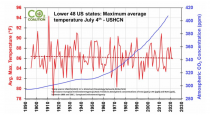
Enlarged
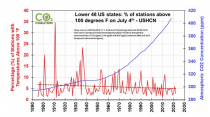
Enlarged
--------
Icecap notes:
The media and the alarmists jumped on forecasts for the hottest summer ever for the US and globe but it has been cold in Russia, India, China, and the US (warm in Canada) in June.
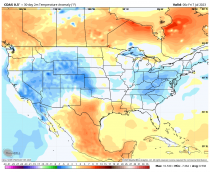
Enlarged
The warmists and their compliant media which had been all over the drought and heat in recent summers in the west, largely ignored the record snows in the. west where ski areas in California and Utah had as much as 900 inches of snow and skiing will continue into August.
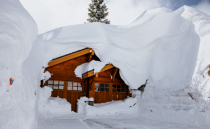
Enlarged
See the history of surface temperatures and how it has evolved from serious scientific study to political driven folly here
See the true heat story in detail here.
See this post reacting to total BS from the UN about the hottest ever summer.
Tony Heller shows it is actually in terms of extreme heat (100 degree temperatures), the coolest summer in the entire record.
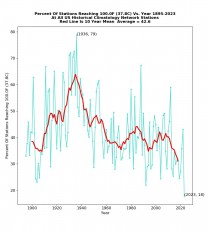
Enlarged
Jun 22, 2023
Global Wind Day, Environmental Nightmare
By Steve Milloy, June 16, 2023
June 15 was Global Wind Day. Its European industry sponsors hope to promote the “power and possibilities” of wind turbines. But beware the Ides of June.
Wind turbines have been sold to us as a means of reducing emissions, global warming and climate change. Although there are a lot of wind turbines installed around the world with many more seemingly to come, they have not reduced emissions, warming or climate change. And they offer no chance to do so, even if those things were desirable.
Coming eight days short of the 35th anniversary of James Hansen’s Senate testimony that sent the world into global warming panic, it’s clear to anyone who cares to look that emissions have nothing to do with recent warming.
Warming since 1980, has been driven by a series of El Nino events that have nothing to do with emissions. Since the last El Nino struck in 2015, the average global temperature has actually cooled slightly despite about 500 billion tons of emissions, which represent a 17 percent increase in industrial era atmospheric carbon dioxide (CO2).
While wind turbines offer no chance of improving the weather or climate, they require taxpayer subsidies and, even though subsidized, have raised electricity prices wherever they have been erected. Wind power has made Germans, for example, think of electricity as a luxury good. And you can trace the ongoing global energy crisis, inflation and even the Ukraine war to the rise of wind power.
But wind turbines are more than just an economic and geopolitical disaster. They are a menace to the environment.
Onshore wind turbines are well know wind turbines kill almost 900,000 bats per year. How green is that?
ICECAP NOTE: An estimated 140,000 to 500,000 birds die each year due to turbine collisions. Bird deaths could soar to 1.4 million per year if the U.S. Department of Energy achieves its goal of expanding wind energy to 20 percent of the country’s electricity demand by 2030.)
The Biden administration is now in the process of permitting the fast-track erection of offshore wind turbines. Although the erection of these 900-foot tall monsters (like a 90-story skyscraper) has not yet occurred, the mere process of site surveying is already wreaking havoc on whales, dolphins, porpoises and seals.
Since December 2022, more than two dozen dead whales have washed up on the New Jersey coast. These deaths have coincided with the commencement of surveying work for offshore wind turbines by foreign and U.S. developers.
While there is no video of the surveying work killing the whales and the Biden administration denies that it is happening, the inconvenient truth is that the government has permitted (in writing) wind developers to kill hundreds of whales, and thousands of dolphins, porpoises and seals.
Although there are only few hundred endangered North Atlantic Right Whales thought to exist, the Biden administration has permitted the wind developers to kill all of them - twice over. In a particularly cynical move, the Biden administration is currently trying to shut down the Maine lobster industry on the basis of a single North Atlantic Right Whale getting tangled in lobster gear 19 years ago.
None of the major green groups like Greenpeace have done anything but defend the wind industry and Biden administration regarding these marine-life deaths. In 1973, Greenpeace coined the phrase, “Save the Whales.” In 2023, it’s apparently been changed to “Kill the whales.” Orwell would love the irony.
Back on land, wind turbines are a permanently scarring feature. Past just being eyesores, each turbine requires an immense foundation of concrete and iron rebar that will be practically impossible to remove if anyone ever wishes to reclaim the land for more sensible use.
Germany’s 30,000 wind turbines are reportedly drying out the soil and contributing to drought, according to a new study.
In Germany and Britain where wind developers have been particularly aggressive, local populations are fighting back with zoning restrictions. So wind developers are looking to change zoning laws to force them down the throats of communities.
In the U.S., so-called “ESG” investors like JPMorgan Chase CEO Jamie Dimon have called for the government to seize land through eminent domain for wind turbines.
Iron Eyes Cody posed as the “Crying Indian” in the 1970s Keep American Beautiful campaign against litter. It’s time for another such campaign against the environmentally destructive wind industry. Just don’t count on the greens to support it. They are as phony as the Italian-born Cody was.
Steve Milloy is a senior legal fellow with the Energy and Environment Legal Institute.
Jun 07, 2023
There is no climate emergency!!!
Clintel
Climate science should be less political, while climate policies should be more scientific. Scientists should openly address uncertainties and exaggerations in their predictions of global warming, while politicians should dispassionately count the real costs as well as the imagined benefits of their policy measures
Natural as well as anthropogenic factors cause warming
The geological archive reveals that Earth’s climate has varied as long as the planet has existed, with natural cold and warm phases. The Little Ice Age ended as recently as 1850. Therefore, it is no surprise that we now are experiencing a period of warming.
Warming is far slower than predicted
The world has warmed significantly less than predicted by IPCC on the basis of modeled anthropogenic forcing. The gap between the real world and the modeled world tells us that we are far from understanding climate change.
Climate policy relies on inadequate models
Climate models have many shortcomings and are not remotely plausible as policy tools. They do not only exaggerate the effect of greenhouse gases, they also ignore the fact that enriching the atmosphere with CO2 is beneficial.
CO2 is plant food, the basis of all life on Earth
CO2 is not a pollutant. It is essential to all life on Earth. More CO2 is favorable for nature, greening our planet. Additional CO2 in the air has promoted growth in global plant biomass. It is also profitable for agriculture, increasing the yields of crops worldwide.
Global warming has not increased natural disasters
There is no statistical evidence that global warming is intensifying hurricanes, floods, droughts and suchlike natural disasters, or making them more frequent.
However, there is ample evidence that CO2-mitigation measures are as damaging as they are costly.
Climate policy must respect scientific and economic realities
There is no climate emergency. Therefore, there is no cause for panic and alarm. We strongly oppose the harmful and unrealistic net-zero CO2 policy proposed for 2050. Go for adaptation instead of mitigation; adaptation works whatever the causes are.
OUR ADVICE TO THE EUROPEAN LEADERS IS THAT SCIENCE SHOULD STRIVE FOR A SIGNIFICANTLY BETTER UNDERSTANDING OF THE CLIMATE SYSTEM, WHILE POLITICS SHOULD FOCUS ON MINIMIZING POTENTIAL CLIMATE DAMAGE BY PRIORITIZING ADAPTATION STRATEGIES BASED ON PROVEN AND AFFORDABLE TECHNOLOGIES.
1551 global scientists (and rising) have signed this agreement. See them here.
May 15, 2023
Media Ignore Delhi’s Coldest May Since 1901
By Vijay Jayaraj
On May 4, India’s capital of New Delhi recorded the third coldest May morning since 1901. At 16 degree Celsius (60 Fahrenheit), the region’s 32 million residents woke up to a relatively cold morning in what is usually the hottest month of the year.

So why is there a record low temperature when the dominant mainstream narrative tells us that climate change has made our environs warmer than before? Is this just an aberration?
While Western media obsessed with the warm weather in Spain, India’s capital recorded a very cold summer morning. In fact, most of the cold-weather records in Delhi have gone unreported in Western media, which are mainly interested in showcasing the city’s extreme summer temperatures.
Neatly concealed from the public’s eye are the record low winter temperatures that Delhi has been witnessing since 2017. In December 2018, Delhi recorded an average minimum temperature of 7C (44F), the third lowest in the last 50 years. On December 30, 2019, the maximum temperature settled at 9C (49F), making it the coldest December day in 122 years.
As is the case globally, winter cold in Delhi is a bigger killer than summer heat. According to studies, short-term exposure to extreme temperature accounts for 6.5 percent of all deaths in India, with 88 percent of that amount caused by cold weather and only 12 percent by hot weather.
This is an example of media bias towards advancing a narrative of apocalyptic warming when reporting weather events. Also, part of this slanted reporting is the media’s failure to acknowledge the real reason behind the recording of all-time high summer temperatures: the urban heat island (UHI).
Urban Heat Island, Not Climate, Sets Records
During my stint as a climate consultant in New Delhi, I lived close to the Safdarjung temperature-measurement station. As per the Indian Meteorological Department, the highest maximum temperature ever recorded at Safdarjung was 47C (117F) on May 29, 1944.
This high temperature recorded nearly 80 years ago for this station has yet to be toppled by the 21st century warming that supposedly threatens us with doom, and the reason is probably the station’s location.
Unlike the other temperature monitoring stations in Delhi, the Safdarjung station is in a relatively greener section of the city. Thus, it is less susceptible to the Urban Heat Island effect, and, therefore, has not been registering the insanely high temperatures of 49C (120F) witnessed in and around Delhi.
Mahesh Palawat, vice-president of Skymet Weather Services, says, “Safdarjung weather station is located in a fairly green area, as compared to the rest of Delhi, which has a lot of heavily concretised spaces without much green cover. Temperatures in these parts of the city will therefore, understandably, be higher.”
So, the reason thermometers record new all-time highs in Delhi is because of urbanization’s concrete structures and pavements and other landscape changes. Weather officials also note that some of the newer automatic weather instruments used in highly urbanized areas may be prone to error.
“Most observatories in Delhi have automatic systems, which have a scope for error because they use bimetals, which can contract and expand during different weather conditions,” says an official of the India Meteorological Department in the Hindustan Times. He added that abnormal temperature spikes of the error-prone stations should be compared to the readings of older stations like Safdarjung to obtain “a more precise idea of the temperature.”
It takes just a bit of common sense to understand the artificial urban heat island impact on thermometers in cities and airports. However, preconceived notions of catastrophic warming pose serious hurdles to grasping this reality.
Delhi’s case illustrates that warming is not a continuous and unprecedented phenomenon as some claim it to be. Instead, we see at play a chaotic climate system at work with unpredictable weather patterns. Additionally, we must be mindful of the urban heat island impact when reading news bulletins about record-high summer temperatures.
Vijay Jayaraj is a Research Associate at the CO2 Coalition, Arlington, Virginia. He holds a master’s degree in environmental sciences from the University of East Anglia, UK and resides in India.
|








